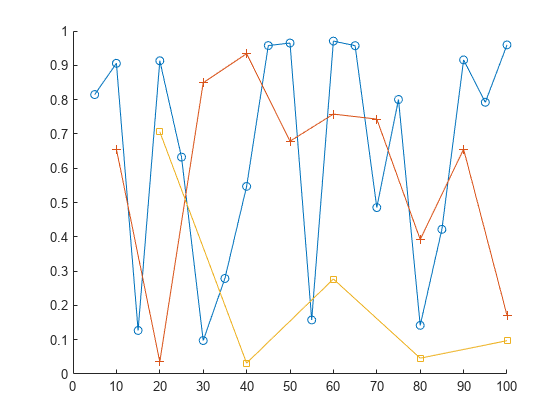arrayfun
Apply function to each element of array
Syntax
Description
B = arrayfun(func,A)func to the elements of
A, one element at a time. arrayfun then
concatenates the outputs from func into the output array
B, so that for the ith element of
A, B(i) = func(A(i)). The input argument
func is a function handle to a function that returns a
scalar. The output from func must always be the same data type to
use this syntax. If the function outputs have different data types, you must set the
UniformOutput name-value argument to
false. The arrays A and B
have the same size.
You cannot specify the order in which arrayfun calculates the
elements of B or rely on them being done in any particular
order.
B = arrayfun(___,Name,Value)func with additional options specified by one or more
Name,Value pair arguments. For example, to return output
values in a cell array, specify 'UniformOutput',false. You can
return B as a cell array when func returns
values that cannot be concatenated into an array. You can use
Name,Value pair arguments with the input arguments of
either of the previous syntaxes.
[B1,...,Bm] = arrayfun(___) returns multiple
output arrays B1,...,Bm when func returns
m output values. func can return output
arguments that have different data types, but the data type of each output must be
the same each time func is called. You can use this syntax with
any of the input arguments of the previous syntaxes.
The number of output arguments from func need not be the same
as the number of input arguments specified by A1,...,An.
Examples
Input Arguments
Name-Value Arguments
Output Arguments
Limitations
Heterogeneous Arrays
arrayfundoes not support heterogeneous arrays whenUniformOutputis set totrue.Difference in Behavior for Input Arrays of Complex Numbers
If the input array
Ais an array of complex numbers, and some of the elements have imaginary parts equal to zero, then callingarrayfunand indexing into the array can lead to different results. Thearrayfunfunction always treats such numbers as complex numbers with imaginary parts equal to zero. However, indexing returns such values as real numbers.To illustrate the difference in behavior, first create an array of complex numbers.
A = zeros(2,1); A(1) = 1; A(2) = 0 + 1i
A = 1.0000 + 0.0000i 0.0000 + 1.0000i
Then create a cell array and assign the elements of
Ato it. When you index intoA(1), its value is returned as a real number because its imaginary part is equal to zero. And you can store real and complex values in different cells ofC1because cell arrays can store data having different types.C1 = cell(2,1); C1{1} = A(1); C1{2} = A(2)C1 = 2×1 cell array {[ 1]} {[0.0000 + 1.0000i]}Call
arrayfunand access the elements ofA. Assign its values to a cell array. WhenarrayfunaccessesA(1), it treats that value as a complex number and assigns it toC2{1}.C2 = arrayfun(@(x) x, A, 'UniformOutput', false)C2 = 2×1 cell array {[1.0000 + 0.0000i]} {[0.0000 + 1.0000i]}
Extended Capabilities
Version History
Introduced before R2006a
See Also
structfun | cellfun | spfun | cell2mat | splitapply | varfun | rowfun | groupsummary
